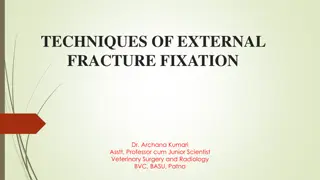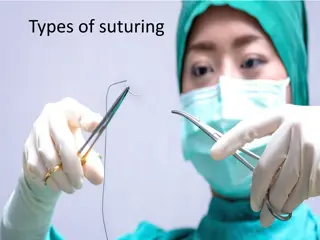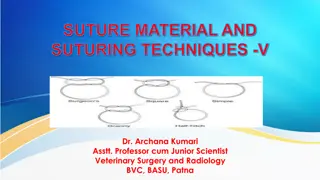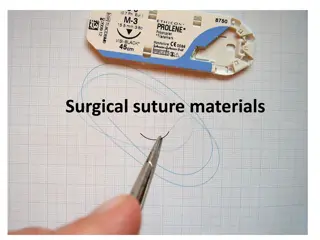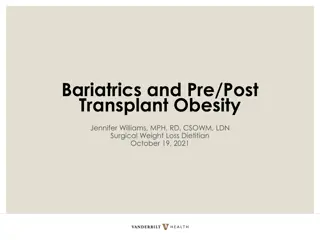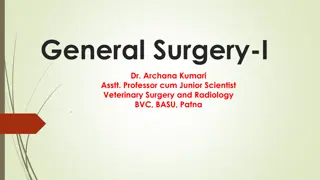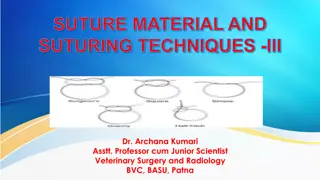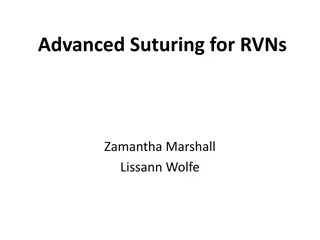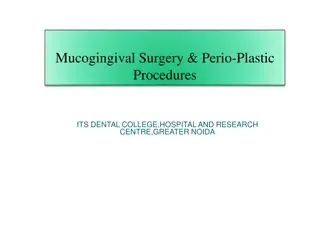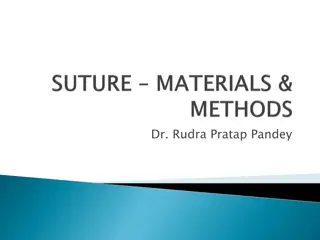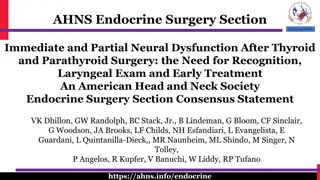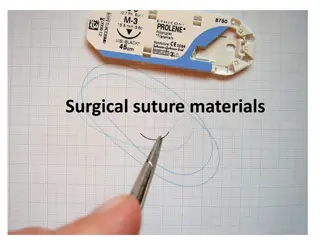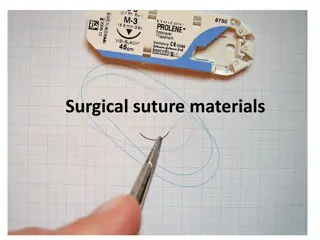Suture Materials and Techniques in Veterinary Surgery: Insights and Guidelines
In this comprehensive guide by Dr. Archana Kumari, explore the goals, characteristics, and armamentarium of suturing, along with suture materials, principles, techniques, and surgical knot considerations. Discover the objectives and qualities of an ideal suture material, as well as the physical structures of monofilament and multifilament sutures. Gain insights into the importance of wound edge apposition, tension management, hemostasis, wound healing, infection prevention, and scar aesthetics in suturing procedures.
Download Presentation

Please find below an Image/Link to download the presentation.
The content on the website is provided AS IS for your information and personal use only. It may not be sold, licensed, or shared on other websites without obtaining consent from the author.If you encounter any issues during the download, it is possible that the publisher has removed the file from their server.
You are allowed to download the files provided on this website for personal or commercial use, subject to the condition that they are used lawfully. All files are the property of their respective owners.
The content on the website is provided AS IS for your information and personal use only. It may not be sold, licensed, or shared on other websites without obtaining consent from the author.
E N D
Presentation Transcript
SUTURE MATERIAL AND SUTURING TECHNIQUES -II Dr. Archana Kumari Asstt. Professor cum Junior Scientist Veterinary Surgery and Radiology BVC, BASU, Patna
DEFINITION Goals of suturing Suture characteristics Armamentarium of suturing Suture materials Principles of suturing Suturing techniques Surgical knot Removal of suture
DEFINITION What is suture? Suture is a stich or series of stiches made to secure apposition of the edges of a surgical or traumatic wound. What is suture materials? Suture materials is an artificial fibers used to keep wound together until they hold themselves by natural.s
GOALS OF SUTURING Wound edge apposition. Provide adequate tension. Maintain hemostasis. Aid in wound healing. Avoid wound infection. Produce aesthetically pleasing scar by approximating skin edges.
Objectives 1. To facilitate healing. 2. Hemostatic. 3. To retain drainage tube and implants. 4. To reduce the size of natural opening.
Qualities of An Ideal Suture Material 1. It should be non-antigenic, nontoxic and non- carcinogenic. 2. It should have mono-filamentous texture. 3. It should have no capillary property. 4. It should have adequate tensile strength in-vitro and in-vivo. 5. It should have good handling property. 6. It should have good knot security. 7. It should be compatible with all kinds of antiseptic disinfectants. 8. It should be easily sterilizable. 9. It should remain intact until union occurs. 10. It should have minimum tissue reaction. 11. It should be cheap and easily available.
CHARATERISTICS OF SUTURE Physical structure: Monofilament- This suture material is smooth & tends to slide through tissues easily. Difficult to knot Can be damaged by gripping it with needle holder or forceps.That can lead to fracture of the suture materials.
Multifilaments- Easy to knot. Have a greater surface area than monofilaments. Have a capillary actions where bacteria may lodge & be responsible for persistent infections. This material can be coated with silicone in order to make it smooth.
SUTURE CHARACTERISTICS Tensile Strength: It can be expressed as the force required to break it when pulling the two ends apart.It depends upon Constituent of suture materials. Thickness of suture materials. How it is handled in the tissues.
SUTURE CHARACTERISTICS Absorbability: Suture materials may be absorbable or non-absorbable. This property must be taken into consideration when choosing suture materials for specific wound closures. Oral mucosa & Deep sturcture need to be absorbable suture materials but vascular anastomoses need non- absorbable suture materials. Biological Behaviour:It depends upon the constituent of raw materials.
Armamentarium of suturing Needle holder A suture needle Suture material
Needle holder Parts: Working tip/jaws Hinge joint Shank/body Catchmechanism/ratchet Grip area
Needle holder How to hold? The needle holder is held with thumb & ring finger through the rings & with the index finger along the length of needle holder to provide stability & control.






